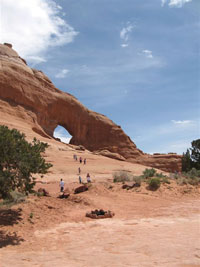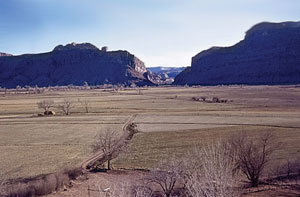The modern-day “tea party” revolt is reminiscent of the Thirteen Colonies’ fight against England’s dominance of the Atlantic Coast in 1776, which is the same year the Spanish conquerors of Mexico sent a cavalcade armed with swords and Bibles into the American Southwest in a quest for land, commerce and Christian converts.

The Old Spanish Trail passed near Looking Glass Rock, located south of Moab.
Photo courtesy of ViviAnn Rose 2009.
|
According to historical accounts, that caravan of Spaniards, led by Catholic priests Francisco Atanasio Dominguez, 34, and Silvestre Velez de Escalante, 24, is commonly credited with blazing a trail in 1776-77 that connected old Santa Fe with “Yuta country,” central Utah -- but they failed in their purported mission to reach Monterey, Calif.
Prior to the north-oriented Dominguez-Escalante expedition, the more commonly used route to California was an east-west journey between Los Angeles and Santa Fe through Arizona that avoided the Grand Canyon. Credited with forging that route in 1775 was another Spanish priest, Fray Francisco H. Garces, 30.
Exactly why Dominguez and Escalante insisted a year later on going north through Colorado and Utah to try and establish a path to Monterey is unknown (although some writers have suggested Escalante really wanted to search for the mysterious “Cibola” and the “seven cities of gold” that Spanish conquistador Vasquez de Coronado tried to find in the 1500s). Ultimately, mountain man Jedediah Smith is credited with making the first successful journey on horseback from Utah to California in 1826.
Nevertheless, the ventures of New Spain in consolidating various pack-and-trade paths that probably originated with Native Americans contributed to the inevitable development of permanent settlements in six states, including Moab, Green River, Provo, Nephi and Cedar City in Utah.
Local interest in the Spaniards’ northward probe in 1776 and others that preceded it and eventually succeeded in reaching California through Utah has taken on new life as planning proceeds on historic and interpretive aspects of rejuvenating the old Lions Park at the Colorado River Bridge.

Looking west at The Portal and Moab Valley (circa 1950s).
Photo courtesy of Barker Family Collection.
|
Some historical accounts suggest travelers on the Old Spanish Trail crossed the river at Moab (known then as the Grand River) near The Portal south of the present bridge, or maybe a little farther upstream. The trail proceeded through the valley (thus the name Spanish Valley), paralleling the Pack Creek drainage, then over Blue Hill and southward, at one point passing an important landmark near the trail, Looking Glass Rock, a natural sandstone arch between Moab and LaSal junction.
There are two main branches of the Old Spanish Trail out of Santa Fe, both ending up in California. In addition, some shortcuts and other smaller branches or “variations” have been noted that break off from the main trail. Altogether, it is the West’s longest historic path, according to the Old Spanish Trail Association (OSTA).
“Plans of the nonprofit Moab Trails Alliance (MTA), Grand County Trail Mix Committee and National Park Service to memorialize the Spanish Trail crossing at the river will entail more than placement of an interpretive plaque at Lions Park,” said Kimberly Schappert of Moab, MTA executive director. Several historical events and sites will be recognized and designated as part of the park’s final design, but the Spanish Trail crossing “is one of the most important ones,“ she said. A request for proposals for a consultant to prepare final drawings for design and construction of the river park will be forthcoming in November.
The Bureau of Land Management is also discussing placement of trail markers along remaining segments that will help people identify, explore and appreciate the ancient path, which is included in the BLM’s National Trail System.
“It was an important trail for people of New Mexico to trade with people in California,” said Lloyd Pierson, retired archaeologist and a well-known historian of Moab. “It was started by mountain men and Spanish traders, trading blankets, furs, skins and slaves -- mostly Paiute, sometimes Utes or Navajos.”
Pierson marvels at “the fact that there was a tremendous amount of traffic through Moab in the good ol’ days.” He said Highway 191 basically follows the trail, which the Utes reportedly used in the 1850s during the Black Hawk War to race to the LaSal Mountains and hide. “Its heyday was before the Civil War in the 1860s. There wasn’t much reason to use the Old Spanish Trail by then,” Pierson said.
This year marks the 25th anniversary of the Old Spanish Trail Association, which succeeded in gaining designation of the centuries-old pack-and-slave-trade route as a National Historic Trail in 2002. In November, the director of the Southern Utah Chapter of OSTA, Edward Leo Lyman, III, of Leeds, Utah, hopes to meet with the Grand County Historical Preservation Commission and others interested in discussing the trail’s local significance and potential for a Moab OSTA chapter. Lyman said a group is also forming in Emery County and in the town of Fremont.

Andrea Stoughton of the Museum of Moab.
Photo courtesy of Andrea Stoughton.
|
With growing interest and organized efforts throughout the region, Utah has a chance of hosting the OSTA national conference in two years, Lyman said, adding that he thinks Moab would be a good place for a national gathering to focus on the Old Spanish Trail, which is historical to the Four Corners states, Nevada and California.
Also in November, the program director for experiential education at the Museum of Moab, Andrea Stoughton, plans to complete a game board she created as part of a program to teach fifth-graders about the Old Spanish Trail and what it meant to the early settlement of Moab.
“What stands out for me,” she said, “is these priests were on a trail that was pretty treacherous back then, and they had horses and supplies and the Indians probably didn’t like white men, so they were pretty brave guys.”
The Old Spanish Trail is “the reason we’re in Moab,” Stoughton said. “It was an expansion.” |


